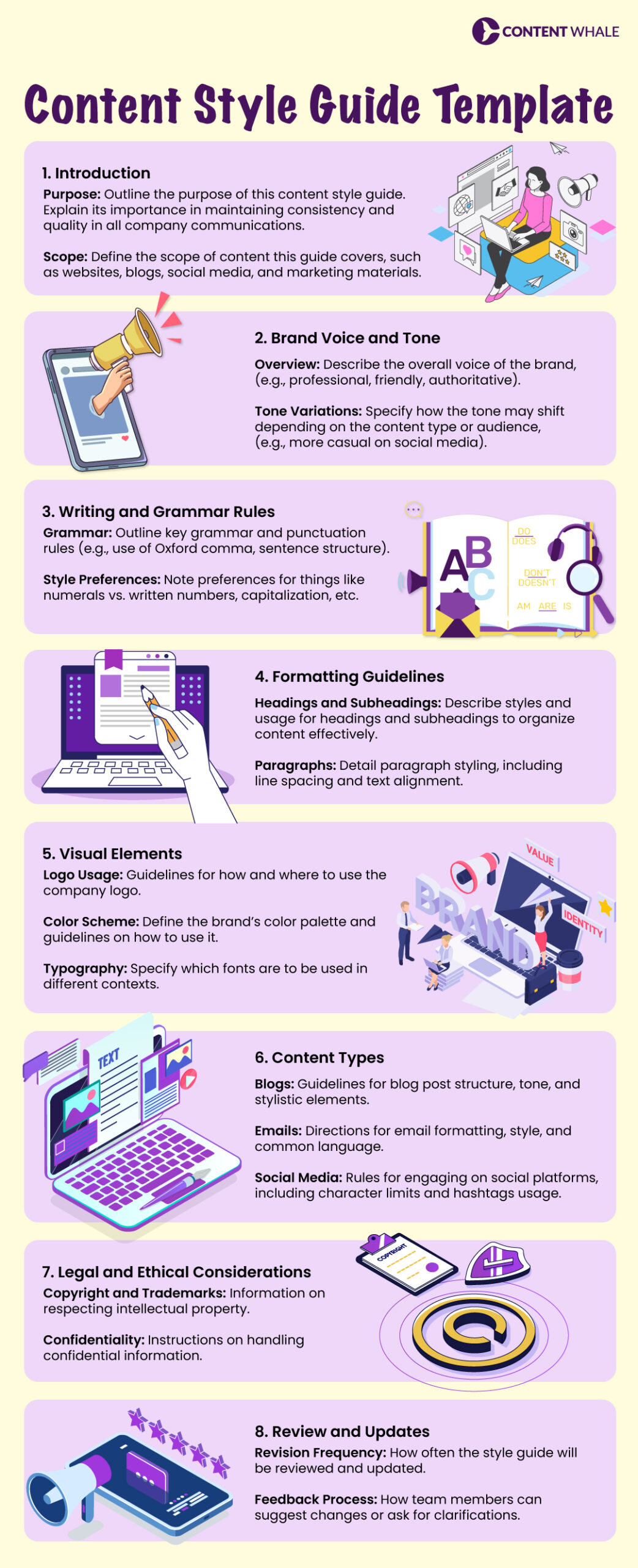Effective communication is the cornerstone of building a strong brand presence. A well-defined content style guide ensures that every piece of content, whether written or visual, aligns with your brand’s voice, tone, and values, thereby fostering a cohesive brand identity.
According to a 2024 study by the Content Marketing Institute, 95% of top-performing B2B marketers attribute their success in part to having a structured content strategy, including the use of a content style guide.
This tool is indispensable not only for maintaining consistency but also for enhancing content clarity and reader comprehension across all platforms.
Definition and Importance
A content style guide is a framework that outlines how all internal and external communication should be styled to align with the brand’s identity. It covers a broad spectrum of elements from grammar and punctuation to tone and visuals, ensuring uniformity across all content types.
The use of a content style guide offers significant benefits such as improved brand recognition and increased audience trust, which are essential for building long-lasting customer relationships.
Implementing a content style guide leads to more efficient content creation processes, reduces discrepancies in how your brand is presented, and helps new content creators understand your brand’s communication style quickly and effectively.
Whether you are creating a blog post, marketing copy, or social media content, referring to a content style guide can streamline decisions and maintain the quality and consistency of your communications.
In the next sections, we will explore how to build a content style guide, drawing on successful content style guide examples and providing you with a content style guide template to get you started.
This guide will serve as an invaluable resource, ensuring that your brand communicates with one coherent voice.
The introduction sets the stage for discussing the strategic formulation of a content style guide, emphasizing its critical role in brand consistency and effective communication.
Unveiling the Power of Brand Consistency with Content Style Guide

Brand consistency is the backbone of audience perception and engagement. Establishing a uniform brand voice and visual identity across all platforms significantly enhances brand recognition and fosters customer loyalty. A content style guide is fundamental in achieving this consistency, acting as a blueprint for all communication and branding efforts.
1. The Impact on Audience Perception
Consistency in your brand’s voice and visuals helps solidify your identity and makes your brand instantly recognizable to your audience. This recognition builds an emotional connection, making it easier for customers to trust and feel familiar with your brand.
For instance, when a brand consistently communicates in a warm and friendly tone, it tends to attract and retain customers who value approachable and personable interactions.
A content style guide ensures that this tone is uniformly applied across all content, enhancing the overall customer experience and brand perception.
2. Consistency Across Platforms
Today’s digital landscape demands that brands maintain a cohesive identity across multiple channels, from their websites and social media to email campaigns and digital advertisements.
A content style guide helps ensure that whether a customer reads a blog post, watches a video, or scrolls through social media, they receive the same brand experience.
This consistency is vital as it reinforces brand values and messaging, which in turn helps to build a strong and loyal customer base.
For businesses aiming to refine their communication across various platforms, a content style guide is an indispensable tool. By defining clear guidelines, such as those found in a content guidelines template, brands can achieve a harmonious narrative that resonates across all media.
Furthermore, by examining content style guide examples, businesses can learn best practices from successful brands to inform their style guide development.
In the following section, we will delve into the specific steps involved in creating a content style guide, providing a practical content style guide template to help you get started. This guide will be a comprehensive tool, aiding your efforts to craft messages that are not only consistent but also true to your brand’s core values and identity.
This section emphasizes the importance of a content style guide in maintaining brand consistency, thereby enhancing audience trust and streamlining content creation across various platforms.
Building Your Content Style Guide: A Step-by-Step Guide

Crafting a content style guide requires careful consideration of your brand’s unique voice, visual identity, and communication goals. This guide will provide a structured approach to defining the essential elements of your brand’s content strategy.
1. Defining Your Brand Voice and Tone
The first step in creating a content style guide is to clearly define your brand’s voice and tone. This involves understanding the personality of your brand and how it should be communicated through words.
Is your brand voice professional, friendly, authoritative, or playful? This voice should resonate with your target audience and reflect your brand’s values.
Once the voice is established, the tone can be adjusted depending on the context or platform. For instance, while the overall voice may be professional, the tone could vary from compassionate in customer service interactions to enthusiastic in promotional content.
Documenting these nuances in your content style guide helps maintain consistency in how your brand communicates in different situations.
2. Formatting and Grammar Standards
Equally important are the standards for formatting and grammar. This section of the content style guide should address various aspects of writing such as punctuation use, headline styles, and the use of abbreviations or acronyms.
Establishing clear rules for these elements ensures that all content produced is polished and professional. For example, deciding whether to use the Oxford comma or specifying capitalization rules can help maintain stylistic consistency across all written materials.
3. Content Structure and Organization
Organizational standards are crucial for making content easy to read and engaging. This part of the content style guide should outline the preferred structure for different types of content, such as how to organize a blog post, the length of paragraphs, and the use of headers.
Guidelines for bulleted lists, numbered lists, and the inclusion of call-to-action statements are also valuable. These instructions ensure that regardless of who creates the content, it meets the same standards of clarity and engagement.
4. Visual and Multimedia Guidelines
For brands that heavily utilize visual content, it is essential to include a section on visual and multimedia guidelines. This should cover the use of images, the brand’s color palette, logo placement, and video production standards.
By specifying the style and appearance of visual elements, your content style guide will help maintain a consistent aesthetic that enhances your brand’s visual identity.
By following these steps and utilizing tools like a content style guide template, you can create a comprehensive guide that ensures consistency across all content channels. This consistency not only strengthens your brand’s market presence but also builds trust and reliability in the eyes of your audience.
Next, we’ll explore some real-world content style guide examples to illustrate how different organizations implement their guidelines effectively.
Inspiration from the Best: Content Style Guide Examples

1. Mailchimp’s Content Style Guide
Here are in-depth case studies of how Mailchimp has effectively used and evolved its content style guide, demonstrating its impact on branding and marketing strategies:
• Mailchimp’s Content Style Guide Implementation
Mailchimp’s content style guide is renowned for its clarity and ease of use, which is crucial in ensuring that all team members can apply it effectively. The guide is structured to be intuitive, with well-organized sections and navigation that includes a search bar and a sequential reading option.
This setup helps new writers and seasoned professionals alike quickly find the necessary information, fostering consistent application across the company’s content. The guide also emphasizes Mailchimp’s unique voice, aiming to be plainspoken, genuine, and jargon-free, which aligns with their brand identity of being direct and user-friendly.
• Evolution of Mailchimp’s Brand and Expansion of Services
Historically, Mailchimp began as an email marketing service but has expanded significantly to include a wide array of marketing services. This expansion was guided by direct customer feedback, which indicated a demand for more comprehensive marketing tools.
Mailchimp’s rebranding strategy wasn’t just about adding new features; it was a strategic shift to position itself as a full-service marketing platform. This shift was communicated through changes in their messaging, moving from “Easy Email Newsletters” to “Build Your Brand, Sell More Stuff.” Such changes in brand messaging were crucial in transitioning Mailchimp’s image from a simple email service to a multifaceted marketing platform, reflecting their broader service offerings.
• Maintaining Brand Voice During Expansion
Despite its significant growth and expansion into new service areas, Mailchimp has maintained its quirky and approachable brand voice. This consistency is key to their content style guide, which dictates a friendly and relatable tone across all communications.
The style guide has been crucial in helping the company navigate its evolution while keeping its core identity intact, especially as they continue to embrace a broad, global audience.
These case studies highlight how Mailchimp’s content style guide has played a central role in both daily content creation and broader strategic branding. By maintaining a clear and consistent brand voice and adapting their services to meet customer needs, Mailchimp has successfully expanded its market presence while staying true to its roots. The thoroughness and adaptability of their content style guide have been key factors in this success.
2. Google’s Material Design Documentation
Google’s Material Design documentation is a robust framework intended to optimize the design process across platforms, making it easier for teams to create consistent, beautiful, and functional products efficiently.
The core of Material Design lies in its adaptability, allowing designers and developers to implement a cohesive design in language that integrates classic design principles with technological innovation.
• Key Components of Google Material Design
- Material Theming and Customization: Material Design offers extensive theming capabilities that allow teams to customize applications to reflect their brand’s unique style without sacrificing usability or aesthetics.
This includes decisions about color, typography, and shape that can be consistently applied across all design elements. This level of customization is supported by tools like the Material Theme Editor, which simplifies these adjustments and ensures that changes are uniformly reflected throughout the product.
- Efficient Collaboration Tools: Material Design also emphasizes collaboration between design and development teams. Tools like the Material Gallery provide platforms for sharing design iterations and feedback efficiently.
This tool supports the transition from design to development by offering auto-generated redlines and specifics about customized components, which streamline the implementation of designs into code.
- Inclusive Design and Accessibility: Google has integrated accessibility into Material Design from the ground up. The framework encourages the creation of designs that are usable for all users, including those with disabilities.
It promotes the use of readable type settings, sufficient color contrast, and clear navigation aids that enhance usability.
- Ongoing Development and Support: Material Design is continuously evolving, with updates that expand its capabilities and components. This dynamic nature ensures that the framework remains relevant as new technologies and design standards emerge.
The documentation is regularly updated to reflect new insights and changes, ensuring that users have access to the latest guidelines and tools.
Google’s Material Design not only aids in building aesthetically pleasing interfaces but also ensures they are practical and accessible, making it a comprehensive toolkit for modern digital product design.
3. Intuit’s Content Design System
Intuit’s content design system exemplifies a comprehensive approach to unified brand messaging across multiple products and platforms, including QuickBooks, TurboTax, and Mint.
This system was developed to consolidate various style guides from across the company into a single, cohesive system. It focuses on clear, inclusive language and a consistent voice that aligns with Intuit’s commitment to diversity and accessibility.
One of the key aspects of Intuit’s system is the inclusion of guidelines that address readability standards, aiming for content that is understandable at a fifth to eighth-grade reading level.
This approach not only makes their content more accessible but also aligns with their goals of inclusivity and customer success. Intuit has also been proactive in revising its language to eliminate terms that could be considered insensitive or non-inclusive, demonstrating a commitment to anti-racist and inclusive communication practices.
Moreover, Intuit has implemented a unique method of integrating these guidelines into the daily workflow of their content creators. By using tools like Writer and creating a Slack bot that incorporates their style guidelines, Intuit ensures that all content adheres to these standards efficiently and effectively. This integration helps maintain consistency across all communications without requiring every team member to constantly refer back to the style guide manually.
Intuit’s approach not only enhances the quality and consistency of the content but also fosters a culture of continuous improvement and sensitivity towards inclusivity and accessibility within the organization.
Their system serves as a dynamic model that other companies can look to when aiming to streamline their content creation processes while emphasizing thoughtful, customer-centered communication.
The Benefits of Real-World Examples
Examining real-world examples from well-established companies like Mailchimp, Google, and Intuit reveals the significant impact that a well-structured content style guide can have on a brand’s communication strategy.
- Mailchimp’s Approach: Mailchimp’s content style guide is crafted to be highly user-friendly, ensuring that even newcomers can navigate its directives with ease. This is accomplished through well-organized sections and intuitive navigation, including search functions and sequential reading options.
By designing the guide in its brand voice, Mailchimp ensures that all content creators can produce materials that are not only consistent but also true to the brand’s identity. This approach enhances the effectiveness of their communication and ensures a unified brand experience across all platforms.
- Google’s Material Design: Google has set a benchmark with Material Design by integrating classic design principles with cutting-edge technology to create a versatile design language.
The comprehensive documentation provided with Material Design assists designers in creating intuitive and aesthetically pleasing interfaces. Moreover, Google supports designers with tools like Material Theme Editor and Gallery, which foster collaboration and streamline the design process, making it easier to maintain consistency across different products and platforms.
- Intuit’s Content Design System: Intuit’s content design system showcases a commitment to clarity, consistency, and inclusivity across its various products. By establishing a unified voice that is adaptable to the specific nuances of each product like QuickBooks and TurboTax, Intuit enhances user understanding and engagement.
The integration of tools like Writer and customized Slack bots into their workflow exemplifies how Intuit keeps its style guidelines practical and accessible, significantly improving the efficiency of content creation and ensuring consistency in communication.
These examples demonstrate that investing in a comprehensive content style guide or design system pays off by improving brand consistency, enhancing customer engagement, and streamlining content creation processes. Each organization’s commitment to these principles not only supports their internal teams but also resonates well with their audiences, fostering a reliable and professional brand image.
Beyond Creation: Maintaining and Updating Your Content Style Guide

Maintaining an up-to-date content style guide is vital for ensuring that your communication remains relevant and reflects the latest in brand evolution and market changes. Regular updates to the style guide help maintain its effectiveness as a tool for consistent and effective communication.
1. Importance of Regular Reviews
Regularly reviewing your content style guide ensures that it evolves alongside your brand and the markets you serve.
As your products or services develop, so too should your style guide to accommodate new communication challenges and opportunities. This might involve updating examples in the content style guide examples, refining voice and tone descriptions, or adjusting guidelines to include new digital platforms.
2. Making the Style Guide Accessible
To maximize the utility of the content style guide, it is essential to keep it accessible to everyone involved in content creation within your organization. An accessible guide ensures that all team members can reference it easily when needed, which is crucial for maintaining consistency across all forms of content.
Whether hosted on an internal server, through cloud storage, or as part of project management tools, ensuring easy access will encourage regular use and adherence to guidelines.
3. Updating Content Guidelines
As market dynamics shift and new content trends emerge, your content style guide should adapt to these changes. For instance, new social media platforms may require updates to the visual and multimedia guidelines, or changes in language sensitivity may necessitate a review of language and inclusivity guidelines.
Utilizing a content style guide template can simplify the process of updating these guidelines by providing a structured framework that only needs specific adjustments rather than a complete overhaul.
4. Training and Workshops
Organizing regular training sessions or workshops can be an effective way to familiarize your team with the content style guide and any updates it undergoes. These sessions can help clarify any changes and provide a forum for team members to ask questions and provide feedback, which can be invaluable for further refining the guide.
The practice of regularly updating and maintaining your content style guide ensures that it remains a relevant and powerful tool for your organization, aiding in the production of consistent, high-quality content that aligns with your brand’s evolving needs.
The Ultimate Content Style Guide Template (Bonus Download)
1. Content Style Guide Template

Offering a content style guide template can dramatically streamline the process of creating and updating your own content guidelines. This section provides a blueprint that can serve as a starting point for organizations looking to formalize their approach to content creation.
2. Key Sections of a Comprehensive Template
A well-rounded content style guide template should cover several crucial areas to ensure comprehensive guidance for content creators. These areas include:
- Brand Voice and Tone: Clearly articulate the personality and communication style of your brand. Include examples to illustrate how the voice should be adapted for different types of content or audience segments.
- Writing and Grammar Rules: Establish standards for grammar, punctuation, and usage to maintain professionalism and clarity across all communications.
- Formatting Guidelines: Specify the layout and styling of text, images, and other elements to ensure consistency in the appearance of content across various platforms.
- Visual Elements: Define the use of logos, color schemes, and fonts that align with the brand’s visual identity. Guidelines for video and multimedia content can also be included to ensure consistency in visual storytelling.
3. Customizing the Template for Your Needs
While the content style guide template provides a strong foundation, it’s important to tailor it to reflect your organization’s specific requirements. This customization involves incorporating your brand’s unique elements into the template and adjusting the guidelines to suit different content types or platforms where your content will appear.
4. Benefits of Using a Template
Utilizing a content style guide template benefits your organization by:
- Enhancing Brand Consistency: Helps maintain a uniform brand voice and style that resonates with your audience.
- Improving Content Quality: Increases the quality of content through standardized guidelines that reduce errors and inconsistencies.
- Streamlining Content Creation: Simplifies the content creation process for new and existing team members, making it easier to produce content quickly and efficiently.
By providing a downloadable content style guide template, we aim to help you develop a robust framework that facilitates the creation of consistent and impactful content tailored to your brand’s objectives. This template not only serves as a practical resource but also encourages adherence to best practices in content development and management.

Successfully implementing a content style guide is more than just about maintaining consistency; it’s a strategic advantage that enhances all aspects of brand communication. The effort to establish and adhere to a set of guidelines reflects a commitment to quality and coherence that resonates deeply with audiences.
Summarizing Key Takeaways
A content style guide serves as a roadmap for all communication, ensuring every piece of content aligns with the brand’s voice, values, and vision.
By detailing specifics from tone and voice to grammar and formatting, the guide ensures that the brand presents a unified front across all channels, which is essential for building trust and recognition.
The Role of Templates and Examples
Leveraging a content style guide template helps streamline the creation and maintenance of your guide. Templates provide a basic structure that you can customize to reflect your brand’s specific needs, saving time and effort in developing a guide from scratch.
Meanwhile, examining content style guide examples from successful companies offers valuable insights into best practices and innovative approaches to effective communication.
Driving Brand Consistency and Content Success
Ultimately, a comprehensive content style guide underpins your strategic communication efforts, supporting everything from marketing campaigns to internal communications. It ensures that every piece of content not only meets quality standards but also contributes positively to the brand’s overall perception and goals.
Encouraging Regular Updates and Engagement
Remember, a content style guide is not a static document but a dynamic tool that evolves. Regular updates are necessary to adapt to new communication platforms, changes in audience expectations, and shifts in the brand’s strategy.
Engaging regularly with the guide—through updates, training sessions, and feedback—ensures it remains relevant and continues to serve its purpose effectively.
Implementing a robust content style guide is an essential step for any brand that values consistency and professionalism in its communications. It is not just about setting rules but about forging a path that leads to deeper connections with your audience and more coherent brand messaging.

This section aims to clarify frequent inquiries regarding the development and implementation of a content style guide.
By addressing these common questions, organizations can better understand the significance and utility of maintaining precise guidelines for all content creation efforts.
What are the different types of content style guides?
Content style guides vary primarily in scope and detail, depending on the organization’s size, the variety of content produced, and the specific needs of the brand. Some guides focus solely on textual elements like tone and grammar (editorial style guides), while others encompass broader communication elements, including visuals and multimedia (comprehensive brand style guides). The choice depends on how extensive the content strategies are across different mediums.
Do I need a separate content style guide for each platform (website, social media)?
Not necessarily. Most organizations benefit from having a unified content style guide that applies to all platforms but includes specific sections that address unique requirements for different channels, such as tone adjustments for social media versus more formal communications for white papers or reports.
How can I enforce the use of the content style guide within my organization?
Enforcement can be achieved through regular training sessions, integration of the style guide into the content creation workflow, and making it easily accessible, such as through an internal wiki or a digital resource center.
Regular audits and feedback can also ensure adherence to the guidelines specified in the content style guide.
How often should I update my content style guide?
Updating a content style guide should be a regular activity, typically annually or biannually, to adapt to new communication trends, technological advancements, and changes in the brand’s strategy or audience expectations.
However, minor updates might be necessary more frequently as new issues or opportunities for clarification arise.
Can a content style guide help with SEO?
Absolutely. A content style guide that includes SEO guidelines, such as keyword usage, meta descriptions, and content formatting, can significantly enhance a website’s visibility and ranking on search engines.
Clear, consistent, and well-optimized content is more likely to meet search engine criteria and improve user engagement.
What tools can I use to create and manage my content style guide?
Several tools can aid in the creation and management of a content style guide. Digital platforms like Google Docs or Microsoft Word allow for easy sharing and collaboration. For more integrated solutions, software like Frontify or Lucidpress provides specialized features for creating, maintaining, and distributing brand guidelines effectively.





